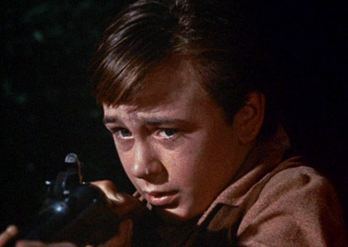We established last week that a belief in the saccharine nature of the animated Disney features, at least, is not supported by the evidence. The claim then became that it wasn’t the animated, of course it wasn’t; it was the live-action that was saccharine. And it’s certainly true that even most theatrical-release Disney features that weren’t released under the Code are rated at most PG. Most of the PG-13 releases have been in the twenty-first century, long after Disney got that reputation. But does that mean it was deserved before then? Oh, not even close.
As with the animation, there are definitely specific movies that we can agree are saccharine. As I recall, that is one of many problems with The Gnome-Mobile, the worst live-action Disney movie I think I’ve ever seen, one I’m actively blocking from my memory. (Though I suppose you could pay me enough to watch it again by contributing to my Patreon or Ko-fi, if you really dislike me.) The Happiest Millionaire, which is also in that bottom tier. We could probably go through the list together and find more than a few others together, though I also suspect that most of the worst offenders are in fact Wonderful World of Disney episodes.
What’s cited most often, of course, is Pollyanna. You know, Pollyanna. The story of an orphan who can’t even remember her own mother, who is forbidden to talk about her much-loved father by the aunt who takes her in as a duty—an aunt who sends her to live in an attic so she can avoid dealing with the child as much as possible. Which features a boiler explosion in an orphanage and a town that discovers the value of socialism instead of relying on the beneficence of the wealthy and has as its dramatic climax a girl falling easily thirty feet or more and being lucky not to die. That Pollyanna.
I’d even say that Pollyanna the character isn’t saccharine. Yes, she goes out of her way to find as much to be glad about as possible, but that’s because she’s spent her whole life longing for a doll and never had one, and the “missionary barrel” she was hoping would include one instead had a pair of crutches, and her poverty-stricken father was trying to find a way to ease his daughter’s disappointment. At least, she and her father agreed, she could be glad she didn’t need them. Pollyanna still feels hurt and anger and disappointment, and she expresses all three. She just actively works to see the bright side of things—and the fact that she has to work to do it shows that there’s a dark side as well.
Now, the obvious counter to “Disney live-action is saccharine” is Old Yeller. My partner suggested that the movie was nothing but wholesome leading up to its famous climax, but this, too, shows a lack of awareness of the movie, which I’m not sure he’s ever seen. If he has, it’s not since childhood. He was astounded when I mentioned that it includes a scene wherein one of the brothers threatens to shoot the other. There’s a bear attack, an attack by feral hogs, and the ever-popular fight with a rabid wolf. And even leaving all that aside, the boys’ father leaves them for almost the entire picture because he has to in order to support the family, leaving a teenage boy in charge.
But, sure, let’s leave aside Old Yeller as being countering issues on easy mode. We could play the “in my lifetime” game here, too, because movies I saw in the theatre as a child include Return to Oz, also known as “one of the darkest movies of Generation X.” Also Flight of the Navigator, where a boy is abducted from his family and returned not having aged for eight years. I don’t remember if I saw Journey of Natty Gann, another pro-socialism period piece, with bonus sexual assault this time, in the theatre, but I definitely saw The Rocketeer and its cavalcade of Nazis there.
Heck, in the earliest days of Disney live action, we’re looking at a whole lot of historical dramas. Treasure Island, which among other things gave us the “talking like a pirate” accent, needs little introduction—and was the introduction to this column. The Sword and the Rose is about a sister of Henry VIII and her political marriage while being in love with someone else. Rob Roy is your standard The English Suck drama about the Highlands. The Disney live-action Robin Hood is bad, but not including anything dark definitely isn’t why. And of course, there’s 20,000 Leagues Under the Sea.
In The Love Bug, Herbie attempts suicide. The mob is a plot point in many Disney movies, including The Absent-Minded Professor. Summer Magic features a family left destitute and an awful lot of family bickering. Bedknobs and Broomsticks has more Nazis. The Moon-Spinners features jewel thieves willing to kill. Pete’s Dragon has childhood slavery. Candleshoe features a child who’s quite aware that foster families only want her for the money. We could keep going. Yes, these are children’s stories, for the most part, but there is anger and passion and fear regardless.
We could do this with the TV stuff, too. Zorro, for starters, which is about government corruption and features, at the end of the first season, a character rather astonishingly like a certain former President. There are Wonderful World of Disney episodes with shootouts; of course there are, given how many there were in the Golden Age of Westerns. But is also a much-loved clip show celebrating the Disney villain. There’s all those wild space ones, including one I’m surprised isn’t brought up more often when people are trying to claim all the animators were on drugs. There’s a lot more than just sweetness and light; no time of Disney had that, no matter what some people think.

